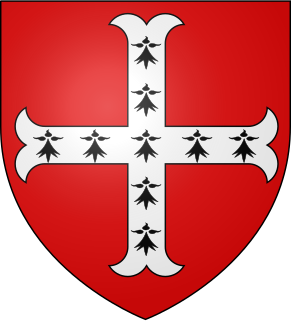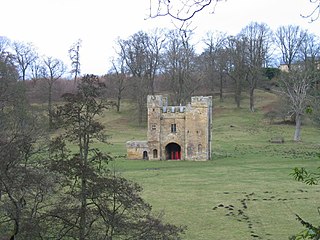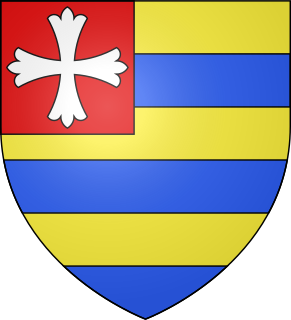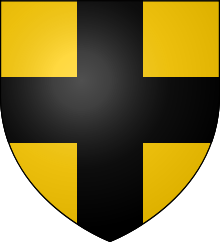
Alnwick Castle is a castle and country house in Alnwick in the English county of Northumberland. It is the seat of The 12th Duke of Northumberland, built following the Norman conquest and renovated and remodelled a number of times. It is a Grade I listed building and as of 2012 received over 800,000 visitors per year when combined with adjacent attraction The Alnwick Garden.

The title of Earl of Northumberland has been created several times in the Peerage of England and of Great Britain, succeeding the title Earl of Northumbria. Its most famous holders are the House of Percy, who were the most powerful noble family in Northern England for much of the Middle Ages. The heirs of the Percys, via a female line, were ultimately made Duke of Northumberland in 1766, and continue to hold the earldom as a subsidiary title.

The title Baron Greystock has been created twice in the Peerage of England. It was first created when John de Greystock was summoned to parliament in 1295.

Antony Bek was a bishop of Durham and the Patriarch of Jerusalem.

The House of Percy is an English noble family. They were one of the most powerful noble families in Northern England for much of the Middle Ages, known for their long rivalry with another powerful northern English family, the House of Neville.

Alnwick Abbey was founded as a Premonstratensian monastery in 1147 by Eustace fitz John near Alnwick, England, as a daughter house of Newhouse Abbey in Lincolnshire. It was dissolved in 1535, refounded in 1536 and finally suppressed in 1539. The Alnwick Abbey site is located just within Hulne Park, on the bank of the River Aln. The only visible remnant is the impressive 14th-century gatehouse, a Grade I listed building.

Eustace de Vesci (1169–1216) was an English lord of Alnwick Castle, and a Magna Carta surety. He also held lands in Sprouston, Roxburghshire, Scotland as brother in-law to King Alexander II of Scotland. Eustace was a leader during the Barons' War in 1215 and was killed while undertaking a siege of Barnard Castle in 1216.

JoscelinePercy, 11th Earl of Northumberland, 5th Baron Percy, of Alnwick Castle, Northumberland and Petworth House, Sussex, was an English peer.

Henry de Percy, 1st Baron Percy of Alnwick was a medieval English magnate.
Eustace fitz John, Constable of Chester, was a powerful magnate in northern England during the reigns of Henry I, Stephen and Henry II. From a relatively humble background in South East England, Eustace made his career serving Henry I, and was elevated by the king through marriage and office into one of the most important figures in the north of England. Eustace acquired a great deal of property in the region, controlled Bamburgh Castle, and served jointly with Walter Espec as justiciar of the North.
Isabella de Beaumont, was a prominent noblewoman allied to Isabella of France during the reign of Edward II of England.
Ralph Fitzwilliam, or Ralph, son of William de Grimthorpe, Lord of Greystoke, was a feudal baron with extensive landholdings in the North of England, representative of a manorial lordship seated where Grimthorpe Hill rises to commanding views a mile to the north of Pocklington in the Yorkshire Wolds. He gave sustained military service and leadership through the Scottish and Welsh campaigns of Edward I and was summoned to parliament from 1295 to 1315. His marriage in c. 1282 brought him other manors including Morpeth in Northumberland and its appurtenances. In 1297 he was enfeoffed as tenant-in-chief of the entire barony of Greystoke, seated at Greystoke in Cumberland but with Yorkshire estates, through his matrilineal Greystok descent. He entered upon these in his own right in 1306. Having served in the retinue of Aymer de Valence, during the first decade of Edward II's reign he remained dependable as a military leader and royal lieutenant in the defence administration of the northern counties and Scottish marches. His descendants adopted the Greystoke name, and their inheritance continued in the male line until the end of the 15th century.

John de Vesci, sometimes spelt Vescy, was a prominent 13th-century noble. He was the eldest son of William de Vesci and Agnes de Ferrers. He married firstly Agnes de Saluzzo and secondly Isabella de Beaumont. John died c. 1289.

William de Vesci or Vescy was a prominent 13th-century noble. He was a son of William de Vesci and Lady Agnes de Ferrers, daughter of William de Ferrers, 5th Earl of Derby, and Sibyl Marshal.
William de Vesci or Vescy was a prominent 13th-century English noble. He was a son of Eustace de Vesci and Margaret, an illegitimate daughter of William the Lion by a daughter of Adam de Hythus.

de Vesci is the surname of an old Norman noble family originating from Vassy, Calvados, also known as the House of de Vesci. The first records are about Robert de Vesci, Norman conqueror and Ivo de Vesci, Lord of Alnwick. The de Vesci family held lands in England and Ireland. The family was also linked to the Scottish Crown through the marriage of Eustace de Vesci to Margaret, the oldest but illegitimate child and daughter of William the Lion by a daughter of Adam de Hythus. William de Vesci was one of the competitors for the Crown of Scotland, upon the death of Margaret, Maid of Norway in 1290.
Ivo de Vesci, sometimes spelt Vescy and first name sometimes Yves, was a prominent 11th-century English noble. He obtained lands and the lordship of Alnwick in Northumberland from King William II of England. He was also given lands in Malton, Yorkshire. It is not known whether he is the son or kinsman of the Robert de Veci who participated in the Norman conquest of England and was rewarded with great estates in the counties of Northampton, Warwick and Lincoln.

Ralph de Greystoke, 1st Baron Greystoke, was an English peer and landowner.

Sir Gilbert de Aton, 1st Baron Aton, of Ayton, Langdon, Malton and Wintringham, Yorkshire was a 13th-14th century English noble. He died c. 1342.
Baron Vesci was a title in the Peerage of England and Peerage of the United Kingdom. It existed as a feudal barony by tenure, before being created by Writ of summons to Parliament of John de Vesci in 1264 until his death in 1289. It was created a second time by writ of William de Vescy in 1295 until his death in 1297. It was created a third time in 1313 by writ of William de Vesci until his death in 1314. The title was created a fourth time by writ of Henry Bromflete, Lord Vescy in 1449 until it became extinct in 1469 upon his death. The title was created a fifth time for John Vesey, 4th Viscount de Vesci in 1884 until his death in 1903 when the title became extinct.













